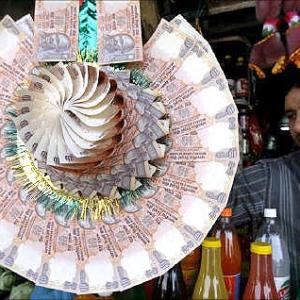Retirees have better options that offer liquidity, better returns and are more tax-efficient.
 After the Union Budget, government officials gave varying comments on taxation of the employee provident fund (EPF) but one thing remained common in their statements - the government wants PF subscribers to take an annuity for pension security.
After the Union Budget, government officials gave varying comments on taxation of the employee provident fund (EPF) but one thing remained common in their statements - the government wants PF subscribers to take an annuity for pension security.
While the idea of creating a pension security is noble, not everyone agrees that investment in annuity is the best option for everyone.
Financial planner Surya Bhatia says, "The first problem with annuity is that the money is blocked for life. Second, the returns are lower than the other financial instruments. Third, the payout from annuity is taxed."
Despite these drawbacks it might still suit some conservative investors, as it covers the reinvestment risks many don't think about, says Amit Gopal, senior vice-president at India Life Capital.
His company provides retirement solutions to companies.
Annuity plans are sold by insurance companies. A person gives the company a lump-sum amount on retirement and, immediately, the company starts paying him pension. The individual chooses whether he wants monthly, quarterly or annual payouts.
Insurance companies offer various annuity products, depending on requirement.
As the product features get attractive, interest rates drop. The highest payout is for a person who takes an annuity plan with no option of taking back the corpus.
For a 60-year-old, who's just retired, the interest rate for such plans are around nine per cent, according to insurance companies.
The annuity stops after the person passes away but one can also take a joint annuity, including a spouse in the plan.
The payout is lower by one per cent in this case and stops after both husband and wife die.
Similarly, one can choose an annuity plan, either single or joint, with return of corpus to the nominee after the pensioner dies.
This is the most popular one, according to Niraj Shah, director, marketing, strategy & products, PNB MetLife.
If a person opts for a single plan, the return is 7-7.5 per cent; in a joint annuity, it drops by about 50 basis points.
There are many more annuity products, though not popular. These include plans where the payout increases at fixed intervals and those where a person gets better returns but only a part of the initial corpus is given back to the nominee on death of the pensioner.
Conservatives like annuity
No instrument, except for annuity, gives a guaranteed return for life. That's the biggest advantage of an annuity product.
A person can invest up to 10 years in long-term bank fixed deposits (FDs). Shah of PNB MetLife says the life expectancy of Indian men is 80-82 years and of women is four years more.
This means after retirement, a person would need to renew his FDs at least twice, exposing him to reinvestment or interest rate risk.
The idea of fixed income for life has many takers and might suit very conservative investors, who don't want to be managing their money to get higher after-tax returns and are fine with lack of liquidity.
According to Gopal of India Life Capital, many employees at senior levels invest in equities on retirement as it can beat inflation in the long term.
But, as the returns from equity investments are not guaranteed, they also use a small portion of their portfolio for an annuity, to ensure they get a regular income, along with investments in other instruments.
It also works out for someone in the tax-free income tax slab, say financial planners.
Better options
Rather than investing in an annuity, a person can use the lump-sum to create his or her own annuity structure that has liquidity, higher returns and is more tax-efficient.
Liquidity is important in old age, when a person might need money urgently for medical emergencies.
A retiree can use a combination of different instruments, depending on requirement and taxation.
Recently, many tax-free bond issues offered around 7.5 per cent annual return for 20 years.
For a person in the 30 per cent and 20 per cent income tax brackets, these work out better than annuity plans.
In an annuity plan offering 7.5 per cent annually, the post-tax return is 4.5 per cent for those in the highest income tax bracket and 5.5 per cent for those in the 20 per cent slab. In tax-free bonds, there is no tax on income.
Similarly, debt funds can work out to be better options, as they offer liquidity and better post-tax returns.
"For regular income, a person can opt for a systematic withdrawal plan or dividend transfer plan from these," says Bhatia.
"In combination with the above, if the corpus is big, one can also look at equity funds with a dividend option," says Suresh Sadagopan, founder, Ladder7 Financial Advisories. These funds offer around six per cent dividend.
Senior Citizens Savings Scheme offers 9.3 per cent return, though the maximum investment one can make is Rs 15 lakh and needs to be renewed every five years.
Other than lower returns, lack of liquidity and taxation, investment advisors also note that an annuity has a service charge on it. Until now, it was 3.5 per cent.
In the Budget, the finance minister has proposed to bring this down to 1.4 per cent on single premium annuity plans.
So, if you were to invest Rs 10 lakh in an annuity, Rs 14,000 flows out as service tax.
This can marginally bring down the net yields. Then, there are commissions if you take help of an agent.
While the regulator allows a commission of two per cent, most insurers give much lower commission on annuity products.










